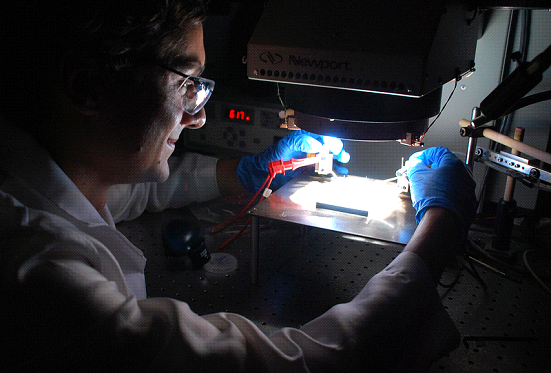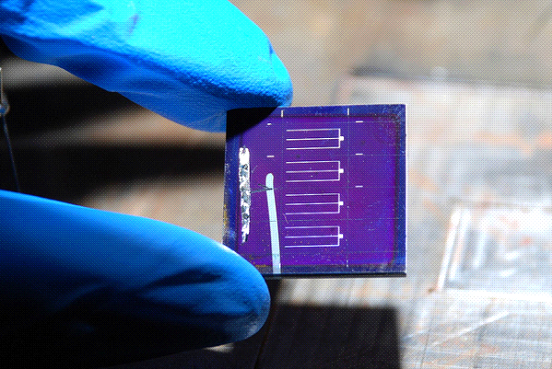11.1% efficiency - a new record in the production of solar panels
Researchers at IBM Research reported on the development of a prototype thin-film solar cell with the world's highest efficiency *
* among those used on Earth

According to scientists from IBM Research, Theodor Todorov and David Mitzi, they managed to achieve the highest efficiency of solar cells in collaboration with Solar Frontier, Del Solar and Tokyo Ohka Kogyo. An article published in the publication Advanced Energy Materials states that a new photovoltaic panel can convert 11.1% of solar energy into electricity in real use, while panels currently on the market have the same figure from 2 to 7%.
Last year, the same scientists and engineers achieved solar cell efficiency of 10.1%.
The fact is that satellites and international space stations use space panels, the efficiency of which is higher than 11%. But they can only be used in space conditions. Plus, they are made on the basis of precious metals and therefore have a very high cost. Although, the first reason why more productive existing batteries are not used on Earth (the absence of suitable conditions) is more weight.
')

All solar panels are arranged in a similar way. They convert the sunlight that falls on them. Or, to be more precise, convert the energy of light photons into electricity. The only difference between one panel and the other is how efficiently it performs this operation: the greater the efficiency, the smaller the required area, and, consequently, the lower the cost.
Discovery by researchers from IBM Research is a thin-film solar cell made of copper, zinc, tin, and selenium (co-labeled CZTS). In addition to the fact that elements are less susceptible to a drop in efficiency with increasing temperature, by today's standards they have a fairly cheap cost (when compared to indium and gallium used in previous CIGS-panels, which are replaced by copper and zinc).
New thin-film solar cells from IBM Research are still being tested in the laboratory. But the developers hope that soon new photovoltaic panels can be put into mass production, and on their basis create solar farms that can become a safe alternative to nuclear power plants and generate terawatts of power. Over time, solar energy will be able to provide electricity to entire megacities, so it is important to start using alternative energy sources right now.

More information: ibmresearchnews.blogspot.com/2012/08/shedding-light-on-new-frontiers-of.html
* among those used on Earth

According to scientists from IBM Research, Theodor Todorov and David Mitzi, they managed to achieve the highest efficiency of solar cells in collaboration with Solar Frontier, Del Solar and Tokyo Ohka Kogyo. An article published in the publication Advanced Energy Materials states that a new photovoltaic panel can convert 11.1% of solar energy into electricity in real use, while panels currently on the market have the same figure from 2 to 7%.
Last year, the same scientists and engineers achieved solar cell efficiency of 10.1%.
Why did I clarify "among those used on Earth"?
The fact is that satellites and international space stations use space panels, the efficiency of which is higher than 11%. But they can only be used in space conditions. Plus, they are made on the basis of precious metals and therefore have a very high cost. Although, the first reason why more productive existing batteries are not used on Earth (the absence of suitable conditions) is more weight.
')
What is the difference of new solar panels?

All solar panels are arranged in a similar way. They convert the sunlight that falls on them. Or, to be more precise, convert the energy of light photons into electricity. The only difference between one panel and the other is how efficiently it performs this operation: the greater the efficiency, the smaller the required area, and, consequently, the lower the cost.
Discovery by researchers from IBM Research is a thin-film solar cell made of copper, zinc, tin, and selenium (co-labeled CZTS). In addition to the fact that elements are less susceptible to a drop in efficiency with increasing temperature, by today's standards they have a fairly cheap cost (when compared to indium and gallium used in previous CIGS-panels, which are replaced by copper and zinc).
What's next?
New thin-film solar cells from IBM Research are still being tested in the laboratory. But the developers hope that soon new photovoltaic panels can be put into mass production, and on their basis create solar farms that can become a safe alternative to nuclear power plants and generate terawatts of power. Over time, solar energy will be able to provide electricity to entire megacities, so it is important to start using alternative energy sources right now.

More information: ibmresearchnews.blogspot.com/2012/08/shedding-light-on-new-frontiers-of.html
Source: https://habr.com/ru/post/150098/
All Articles